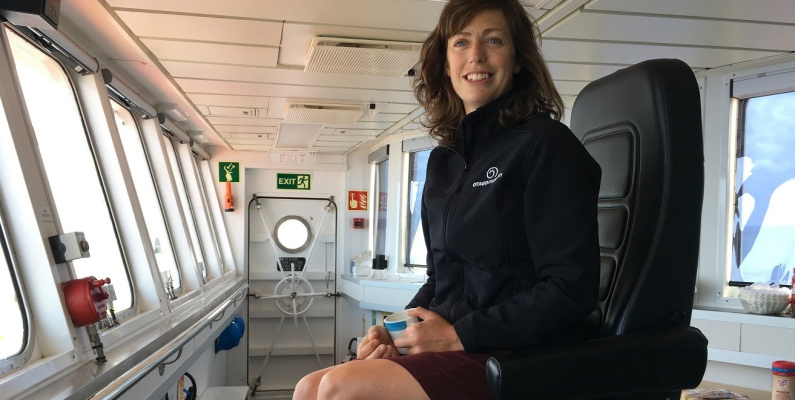
Kia ora! I’m Claire, the Science Outreach Projects Coordinator at Otago Museum. For the next month I will be working as the onboard outreach officer on the ship the JOIDES Resolution, for Expedition 378: South Pacific Paleogene Climate. I’ll be blogging about my adventures here, but you can also follow the ships social media accounts on Facebook, Instagram, and Twitter.
Blog Post Nine – What lies beyond the labs
I’ve been living and working away in my own little part of the ship for a while now. Office, conference room, science labs, galley, gym, movie room, cabin these are the spaces I move between. But outside of these spaces there are a whole other worlds of operations and crews of people who run them. Welcome to the rest of the ship.
First up is the bridge. It’s got all the things you would expect to see on the bridge of a ship – radar, sea chats, compasses, radio, except for a big ship’s wheel… instead of a large, grand (possibly wooden, brass plated, with large handles) steering wheel there is just a small compact black one. Disappointing. Anyway, when the ship is moving there has to be someone on the bridge on look out at all times, and two people at night time. When the ship is on autopilot there are motion sensors that activate, if they don’t detect movement in a certain amount of time the system will presume that there is nobody on lookout (or they have fallen asleep!) and an alarm will sound in the captains room (Captain Jake in our case). So we can be sure there is always someone keeping an eye out.

Image: My colleague Lindy tries out the quite-small ship’s wheel. By Claire Concannon © Otago Museum By Claire Concannon © Otago Museum
Also in this bridge area is the dynamic position system, the setup that keeps the ship steady while we are drilling. Now ‘dynamic positioning’ was first invented for the very first science seabed drilling project, the wonderfully named Project Mohole, but at that stage it was four manually controlled motors stuck to the bottom of a barge. Today, the JOIDES Resolution has 12 thrusters that get lowered when we are at the drill site, and reading from the ship’s GPS and wind and position sensors, this automated dynamic positioning system is continuously calculating and adjusting the thrusters to keep the ship in place. Drift too far off, and you risk snapping the drill pipe assembly, which is, to vastly understate it, a bit of a disaster.
Aft of the science labs (Avast, me hearties, some ship lingo!) is where the drilling deck, derrick, and dog house are located. This is where the drilling magic happens. The drill floor sits above the moonpool – which is the name for the hole in the bottom of the ship through which the drill pipe passes. On the drill floor the team will put together the bottom hole assembly (to attach the drill bit to the drill pipe, and to give weight and support to the bit) and then begin to attach metres upon metres of drill pipe. The term is ‘tripping pipe’ and its pretty amazing to watch. An automated conveyer belt stacks 28.5 m lengths of drill pipe horizontally before they get flipped vertically by a crane hanging from the derrick and then attached to the previous piece of pipe, and so on and so on. This, and the drilling that happens, is controlled from the ‘dog house’, the place where the driller sits and works satisfyingly large levers while keeping an eye on massive pressure gauges. That’s more like it.


Image: (L) Checking out some gauges in the dog house with Kevin the operations manager By Claire Concannon © Otago Museum (R) Hundreds of metres of drill pipe are stored onboard and lifted up to the drill deck by an automated system By Claire Concannon © Otago Museum
Below and beyond the drilling area are the fresh water generators and the engine room. The ship makes all its own freshwater out of sea water, the generators work under a vacuum so the evaporation temperatures are lower than at atmospheric pressure. Seawater is boiled off using waste heat energy from the main energy cooling water circuit, and then fresh water vapour is condensed by circulating the cooler sea water. The ship has five main engines and two auxiliary engines, and it is loud and hot down there! They create energy to power the ship’s electricity needs and to drive the massive propellers.
Finally, right at the back of the ship is the heli deck. It is there for medical emergencies and it has been used in the past for people to be air lifted off the ship when accidents have happened. It’s also a nice place to bird watch, and, if you like, to go for an outside run, albeit in very small circles…

Image: View of the derrick from the heli deck. By Claire Concannon © Otago Museum
Now that we are drilling you can really see the ship in full flow. Everybody on board is working hard, each on their own little part, and we have really set into a rhythm that fits into the whole objective of the expedition – getting those cores on board so we can learn more about what was happening in Zealandia millions of years ago, more on that next….
Top Image: Just me drinkin’ some coffee, sittin’ in the captain’s chair…. Could get use to this. By Claire Concannon © Otago Museum
